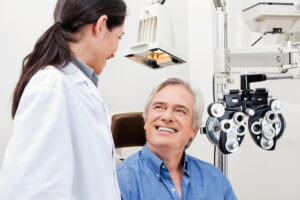With age, several different eye conditions can affect you. One of the most common age-related eye conditions is cataracts.
By the time most people are 75 or older, at least half will have already had a cataract. But age isn’t the only reason someone develops cataracts.
They can also be something you’re born with, develop due to medications like corticosteroids, or an injury to the eye or face. Although you’re at a higher risk of developing them, anyone can get them once you turn 40.
But what exactly are cataracts, and how do they affect your vision? Keep reading to learn more about cataracts and how to treat them when you start developing them.
What are Cataracts?

Cataracts develop on the natural lens of the eye when proteins on the lens begin clumping together. As these proteins start clumping together, it affects your ability to see.
When you have a cataract, it causes the lens to become cloudy and more challenging to see through. If you have cataracts, you may not realize it right away.
They develop over several years or even decades. In the beginning, you may not even notice any visual changes.
But as they continue maturing, they can make it very hard to see clearly. Eventually, when left untreated, cataracts can even cause total blindness.

What are the Most Common Cataract Symptoms?
Cataracts have a variety of symptoms, including:
- Blurry vision
- Halo and glare around lights
- Light sensitivity
- Poor night vision
- Trouble seeing contrast
In the early stages, many people don’t even notice these symptoms. Since cataracts develop so slowly, it can be hard to notice when these symptoms become more evident.
How Cataracts and Presbyopia are Different

Often, cataracts are confused with presbyopia. Like cataracts, presbyopia is a common age-related eye condition that makes it harder to see up close.
Presbyopia occurs when the natural lens loses flexibility, making reading glasses necessary. Many people with cataracts also have presbyopia and experience similar symptoms, so it can be hard to differentiate between them.
The critical thing to remember with cataracts is that they don’t affect your ability to see up close. However, they make it harder to see things up close when you’re in low light.
People with developed cataracts often have trouble reading without a direct light source. If you have a cataract, you may also struggle to drive at night due to poor night vision and glare from car headlights.
Difficulty driving at night is one of the sure signs of advanced cataracts. Ideally, have your cataracts diagnosed before they cause significant visual issues.
Who Can Develop Cataracts?
Anyone can develop cataracts. It is almost inevitable that you will develop cataracts due to aging. But most people start developing cataracts in their forties and fifties.
You’re at a higher risk of developing cataracts at an earlier age if you:
- Use tobacco
- Drink heavily
- Have spent excess time in the sun without adequate protection
- Have diabetes

You can lower your risk for cataracts by eating a balanced diet, staying active, drinking in moderation, wearing sunglasses, and refraining from smoking and using other tobacco products. There is no way to ensure you will never have cataracts.
Even if you try to lower your risk of them, there’s a good chance you may still develop them when you’re older. However, you cannot prevent cataracts.
All you can do is lower your risk of developing them earlier. You may have cataracts, but you’re less likely to develop them sooner if you reduce your risk by leading a healthy lifestyle.
Diagnosing and Treating Cataracts
The best way to have your cataracts diagnosed is by scheduling regular eye exams with your eye doctor. Once you’re 40 or older, your risk of developing age-related eye conditions, including cataracts, increases.
Regular eye exams with your eye doctor help ensure these conditions are spotted early and treated promptly. If you’re over 40, you should see an eye doctor for a routine exam at least once every two years.

How often you need eye exams may change if you have a family history of glaucoma, age-related macular degeneration, or other eye conditions. Some patients may need annual eye exams to ensure their eyes stay healthy. Talk to your eye doctor about what kind of schedule you should be on if you’re unsure.
You should also schedule an appointment with an eye doctor if you experience cataract symptoms. Your eye doctor should spot any early signs of a cataract during an eye exam.
If they discover these, they will continue to monitor subsequent cataract development. However, even if you have a cataract, that doesn’t mean that you’ll necessarily need to have cataract surgery right away.
During the early stages, cataracts are usually unintrusive. Cataract surgery, which is the only treatment for cataracts, is recommended when your cataracts begin to affect your quality of life.
Because they can develop so slowly, it may be years before they start affecting your vision. But when they do, cataract surgery is the only way to restore your vision.
What Can I Expect During Cataract Surgery?

Cataract surgery is the only treatment for cataracts. It’s one of the most commonly performed procedures in the country.
It’s highly effective and low-risk. It can restore your vision even if you’ve experienced vision loss due to cataracts.
Cataract surgery removes your natural lens and replaces it with an artificial lens called an intraocular lens (IOL). Removing your natural lens is the only way to take your cataract out.
There are many kinds of IOLs, and some can even correct other visual issues like presbyopia and astigmatism. When you get cataract surgery, your Sierra Nevada Eye Center surgeon will talk to you about different IOL options and which one may be best for you.
They’ll help you decide what IOL will be the best fit for you based on your visual goals after cataract surgery and your lifestyle needs. In many cases, you may be able to reduce your dependence on glasses if you choose a premium lens.
Cataracts can be debilitating, but there’s a reliable way to treat them. If your cataracts have begun to affect your quality of life, it may be time to have cataract surgery. Schedule an appointment at Sierra Nevada Eye Center in Reno, NV, to learn more.


